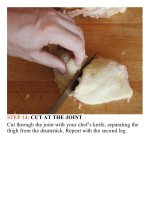The food lab better home cooking through science ( PDFDrive ) 794
Bạn đang xem bản rút gọn của tài liệu. Xem và tải ngay bản đầy đủ của tài liệu tại đây (133.6 KB, 2 trang )
and is significantly firmer, juicier, moister, and more
tenderthaneitherrareormediummeat.
• 140°F (medium): Solid rosy pink and quite firm to the
touch. Still moist but verging on dry. The fat is fully
renderedatthisstage,deliveringplentyofflavor.
• 150°F (medium-well): Pink but verging on gray. The
moisture level has dropped precipitously, and the texture
is chewy and fibrous. The fat has fully rendered and
begun to collect outside the roast, carrying away flavor
withit.
• 160°F(well-done): Dry, gray, and lifeless.The moisture
loss is up to 18 percent, and the fat is completely
rendered.
Justlikewithbeef,Ipersonallyrecommendcookinglambto
at least medium-rare—it’s hot enough that the abundant fat
inthemeathasbeguntomelt,lubricatingandflavoringthe
meat.Rarelambistougherandlessflavorful.
Q:So,ifI’mcookingitintheoven,whattemperature
shouldIuse?
Just as with cooking any large piece of meat, you’ve got a
decisiontomakerightoffthebat:doyouwanttocookhot
or cool? Cooking in a high oven will obviously get dinner
on the table much faster, but it’ll also result in far more
uneven cooking, with the outer layers of the meat
overcookingandturninggraybythetimethecenterisdone.
Now, I understand that some people don’t mind this. I like
having some juicy medium-rare meat and some tougher
well-done meat on my plate, they say. Those of you who
feel this way should be thankful—it makes cooking roasts
veryeasy.Justbangitintoahotoven(around400°Fshould
do) and roast until the very center reaches the desired
temperature.
Butifyou,likeme,wantyourlambevenlycookedfrom
edges to center, the best thing to do is slow-roast it, just as
whencookingprimerib(seePerfectRoastPrimeRib,here):
Place it in a 200°F oven until it is within a few degrees of
your desired serving temperature (use that thermometer!).
Remove it, crank the oven up as far as it will go, and let it
heatup,thenthrowthelambbackinforabout15minutesto
crispupthewell-renderedfatlayerontheexterior.
Q:DoIhavetoletmylambrestjustlikebeef?
Just as with a steak or a beef roast, lamb muscles tighten
when they’re hot. As they loosen up during resting, their
abilitytoretaintheirjuicesincreases.Thismeansthatmore
juice ends up in your meat and less on the cutting board.
Allowlambroastedentirelyatahightemperaturetorestfor
at least 20 minutes after removing it from the oven, and
meatroastedlow-and-slowtorestforatleast10minutes.
CARVINGABONE-INLEGOF
LAMB
W
hen you’ve got a bone-in leg of lamb, you’ll









